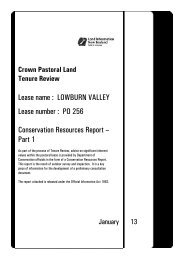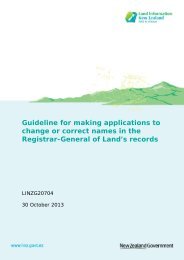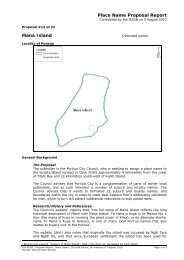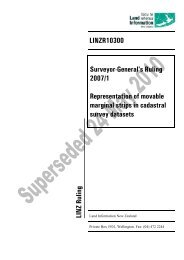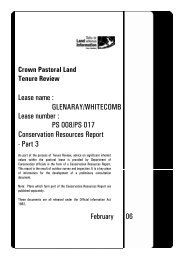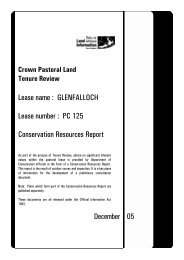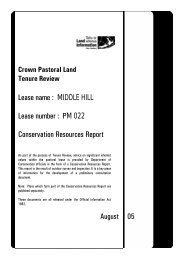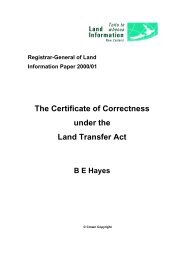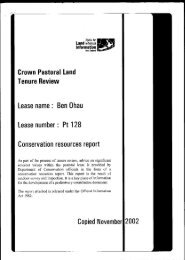Crown Pastoral-Tenure Review-Lake Hawea-Conservation ...
Crown Pastoral-Tenure Review-Lake Hawea-Conservation ...
Crown Pastoral-Tenure Review-Lake Hawea-Conservation ...
Create successful ePaper yourself
Turn your PDF publications into a flip-book with our unique Google optimized e-Paper software.
RELEASED UNDER THE OFFICIAL INFORMATION ACT<br />
burning. Some exposed rock outcrops in this zone have retained a native herbaceous flora<br />
including the rare Pachycladon cheesemanii (=Ischnocarpus novae-zelandiae), Vittadinia<br />
australis, Senecio quadridentatus and bristle tussock (Rytidosperma setifolium). Further up<br />
the catchments, particularly on south-facing slopes, are more extensive mixed native<br />
shrublands and occasional beech forest remnants.<br />
Shrublands are generally dominated by mingimingi and Olearia avicenniifolia, but other<br />
common shrubs and trees include broadleaf (Griselinia littoralis), kowhai (Sophora<br />
microphylla), Coprosma rugosa, fuchsia (Fuchsia excorticata) koromiko (Hebe salicifolia),<br />
Olearia lineata, mountain wineberry (Aristotelia fruticosa), desert broom (Carmichaelia<br />
petriei), matagouri and porcupine shrub (Melicytus alpinus). Native jasmine (Parsonsia<br />
heterophylla), bush lawyer (Rubus schmidelioides) and pohuehue (Muehlenbeckia complexa)<br />
are common lianes; less common is climbing aniseed (Scandia geniculata). The delicate star<br />
lily (Arthropodium candidum) occurs in open places around the shrubland margins.<br />
At highest altitude are narrow-leaved tussock grasslands, and alpine rock and scree<br />
communities similar to those described for Bushy Creek below.<br />
B2 Bushy Creek:<br />
Bushy Creek disgorges from its steep headwaters across a wide alluvial fan built up from the<br />
actively eroding catchment. This regularly disturbed fan has a discontinuous cover of<br />
bracken, briar (Rosa rubiginosa), buddleia (Buddleia davidii) and matagouri. Higher up the<br />
valley, a fenceline running parallel with the creek delineates native shrublands on the true<br />
right, from much more frequently burned land on the true left, dominated by bracken and<br />
woolly mullein (Verbascum thapsus).<br />
True right shrublands and shrublands occupying the fan between the two upper tributaries are<br />
dense and diverse. The rare tree daisy Olearia fimbriata dominates but other common<br />
species include O. avicenniifolia, mingimingi, mountain wineberry, broadleaf, kohuhu<br />
(Pittosporum tenuifolium), koromiko and tutu. Bracken and porcupine shrub are common in<br />
gaps. Lianes are also plentiful and include native jasmine, bush lawyer and pohuehue.<br />
Above the confluence of the two upper tributaries mountain beech forest occupies the steep<br />
valley sides. This is bereft of an understorey with the exception of occasional Coprosma<br />
ciliata. The mountain beech trees are host to abundant red mistletoe (Peraxilla tetrapetala)<br />
and the epiphytic hanging spleenwort (Asplenium flaccidum). Ground cover is predominantly<br />
moss with Acaena profundeincisa and occasionally Pterostylis sp.<br />
Some exposed rock bluffs on the northern tributary have the rare cress Pachycladon<br />
cheesemanii (=Ischnocarpus novae-zelandiae). These sparsely vegetated dry sites also<br />
support blue tussock (Poa colensoi), Stellaria gracilenta and Brachyglottis southlandicus.<br />
In the upper catchment above the bushline, slopes become increasingly steep, eventually<br />
forming exposed rocky ribs and outcrops interspersed with steep screes. Relatively stable<br />
ground with soil development supports narrow-leaved tussockland but rocky, more eroding<br />
sites, have a sparse vegetative cover of low shrubs and herbs. Common species include Hebe<br />
epacridea, H. buchananii, H. pinguifolia, edelweiss (Leucogenes grandiceps), Pachycladon<br />
(= Cheesemania) enysii, Celmisia densiflora, Leptinella pectinata subsp. villosa,<br />
Colobanthus sp., Cardamine sp., Carmichaelia vexillata and Aciphylla montana.<br />
DOCDM-372005 <strong>Lake</strong> <strong>Hawea</strong> CRR - Info.doc 12



